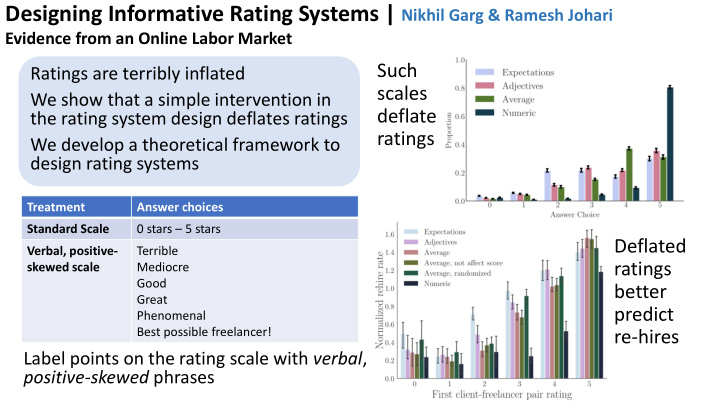



Designing Informative Rating Systems | Nikhil Garg & Ramesh Johari Evidence from an Online Labor Market Such Ratings are terribly inflated scales We show that a simple intervention in deflate the rating system design deflates ratings ratings We develop a theoretical framework to design rating systems Treatment Answer choices Standard Scale 0 stars – 5 stars Deflated Verbal, positive- Terrible ratings skewed scale Mediocre Good better Great predict Phenomenal Best possible freelancer! re-hires Label points on the rating scale with verbal , positive-skewed phrases
Theoretical approach Suppose we have estimated a joint distribution between seller quality and the ratings the receive, Pr y| መ 𝜍(y , 𝜄) = ො 𝜄 , for each possible rating scale Under our (stylized) model… • Sellers accumulate ratings according to 𝜍 • Platform estimates ranking by empirical rating average • Estimated ranking converges to true ranking, at a large deviations rate that depends on 𝜍
More generally, a framework for designing the information received from platform participants. Platform Design Information Platform Objective Learning about participants Question asked Answer distribution Experiment: How does platform Theory: How does the response design affect response distributions? distribution affect learning? Estimated Truth Error k ≈ 𝑓 −𝑙𝛿 𝑒𝑓𝑡𝑗𝑜 Rate 𝛿 𝑒𝑓𝑡𝑗𝑜 at which platform recovers truth can be calculated after an experiment Designing Informative Rating Systems: Evidence from an Online Labor Market [w/ R. Johari] Designing Optimal Binary Rating Systems [w/ R. Johari] Who is in Your Top Three? Optimizing Learning in Elections with Many Candidates [w/ L. Gelauff, S. Sakshuwong, A. Goel]
Optimal systems with various platform goals Suppose a (commodity-heavy) marketplace primarily wants to separate the bottom 5% of sellers from everyone else. What rating system should it use? • In a follow-up paper in AISTATS*, we • Develop a non-convex optimization algorithm to find the optimal system • Show how information goals should be incorporated into design • In the above example, inflated ratings are optimal *Designing Optimal Binary Rating Systems
Recommend
More recommend